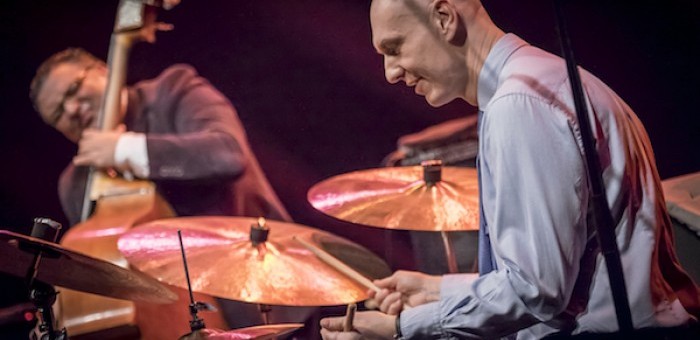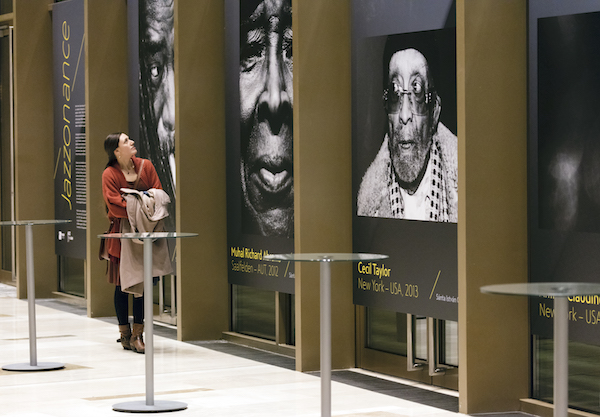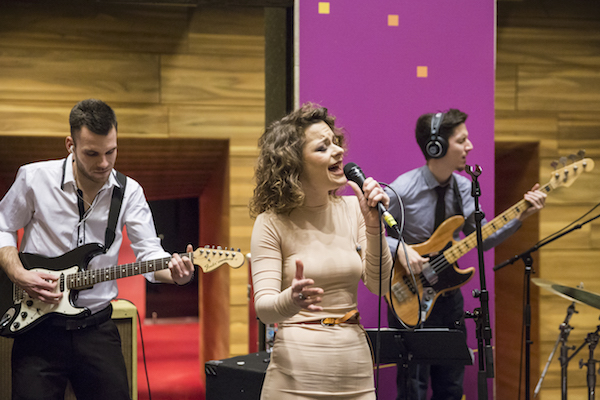Apr 2, 2024 12:59 PM
Saxophonist, Sonic Explorer Casey Benjamin Dies at 45
Casey Benjamin, the alto saxophonist, vocalist, keyboardist and producer who stamped his distinctive sounds on the…

Balázs Bágyi (right), president of the Hungarian Jazz Association, performs with his New Quartet during the Hungarian Jazz Showcase and Talent Exchange, which ran Feb. 3–5.
(Photo: Kotschy Gabor)Hungary staked its claim as jazz capital of Central Europe February 3–5 as the arts center Müpa Budapest—comparable to the Kennedy Center in Washington, D.C., —staged its 10th annual Jazz Showcase and Talent Exchange.
The weekend’s smoothly organized events demonstrated both an international level of musicianship and a distinctly native flavor. There was a competition in which nine locally based acts vied for future gigs, performing afternoon sets in informal spaces for crowds of 60 to 100 listeners; an impressive exhibit of Sánta Istvan Csaba’s photos of American jazz masters; two panel discussions; and three evening concerts of regionally-rooted stars, held in Müpa’s well-designed theaters.

Photo: A festival attendee peruses the exhibit of Sánta Istvan Csaba’s photos of American jazz masters. (Credit: Posztos Janos)
The stylistic variety of the Showcase/Talent Exchange contestants was exemplified by its vocal acts. The Cintia Horváth Quintet dramatically interpreted standards and ballads. Mariann Németh Szabo’s quartet Girly Groove served up bouncy pop tunes. Petra Kész in her trio Cymbal Rush delivered an exotic mélange of extended vocal techniques and range, electronics effects and original song forms. Sultry soul-singer Janka Vörös fronted e-Series, a well-rehearsed yet funky band.
Photo: Cintia Horváth (right) with members of her quintet perform at the Hungary Jazz Showcase/Talent Exchange. (Credit: Kotschy Gabor)
All the women sang in English, giving a colorful lilt to the familiar lyrics of “My Foolish Heart,” “Superstition,” “On Broadway” and Betty Wright’s “Cleanup Woman,” among other hits. Horváth and Vörös were both abetted by saxophone and guitar soloists, as well as solid bass and drum support. Kész offset her gleeful chants, wild wailing and loops with a pianist who gave his improvisations a classical touch and a drummer who kept simple yet effective time.
The non-vocal groups were equally diverse. The trio Jazzbois created a synth keyboard-guitar-drums electro-groove. Drummer Toni Snétberger’s Roma (gypsy) quartet featuring guitarist Csaba Danyi and pianist Zsolt Farkas tapped the guitar-piano vibe of Wes Montgomery’s recordings with Wynton Kelly, playing “Jordu” and “Impressions.” Alto saxophonist Gábor Baris’ folksy quartet Gino’s B Version, featuring the invigorating drummer Akos Benkó, earned a special award from the Hungarian Jazz Association.

Photo: Janka Vörös (center) and members of her e-Series band. (Credit: Palyi Zsofia)
The prestigious jury award—conferred by a panel of Hungarian guitar hero Gyula Babos, U.K. presenter/producer/manager/administrator John Cumming, Budapest Jazz Club programmer Péter Pallai, Budapest cultural journalist Kornél Zipernovszky and this reporter—went to the quartet of alto and soprano saxophonist Tamås Ludányi, who, with impassioned pianist Aron Tälos, personalized Coltrane’s compositions and freedoms.
Polling of the Showcase/Exchange audience over three days resulted in the crowd’s award going to singer Vörös. Her prize is to headline a free, open air Müpa concert next summer. The Zemplén Festival, held in June in the wine-producing northeastern province of Hungary, rewarded Cintia Horváth and pianist Gyula Balogh’s quartet with the promise of upcoming appearances.
The main concerts on Feb. 3 and 4 took place in Müpa’s 459-seat Festival Theater. Hungarian-Slovakian drummer David Hodek, with Americans Paul Cornish (piano) and Joshua Crumbly (bass), played chilled-out versions of repertoire by J Dilla and Herbie Hancock (“Maiden Voyage”).
Drummer Balázs Bágyi, president of the Hungarian Jazz Association, drove his New Quartet. Chinese trumpeter Li Xiaochuan was a special guest, interweaving his tightly focused sound in loose cohesion with saxophonist Sandor Lakatos on one composition alternating 5/4 and 6/8 sections, as well as another titled “Shanghai Blues” and a jazz waltz.
The weekend climaxed in a sold-out gala concert in Müpa’s 1600-seat Béla Bartok National Concert Hall. Attila László, faculty member of the local Franz Liszt Academy of Music, conducted the 18-piece Senior Big Band, starting with “I Got Rhythm” as arranged by Rob McConnell. Then the orchestra accompanied winners previous Jazz Showcase/Talent Exchanges in spotlit turns.
For the finale, tenor saxophonist Gábor Bolla provided powerful obbligato for singers Juli Fábián, Veronika Harcsa and Bálint Gájer, harmonizing on “Almost Like Being In Love” from the 1947 Broadway musical “Brigadoon.” These Central Europeans swung hard, with precision, polish, and complete commitment to jazz in the contemporary, global idiom. DB

Benjamin possessed a fluid, round sound on the alto saxophone, and he was often most recognizable by the layers of electronic effects that he put onto the instrument.
Apr 2, 2024 12:59 PM
Casey Benjamin, the alto saxophonist, vocalist, keyboardist and producer who stamped his distinctive sounds on the…

“He’s constructing intelligent musical sentences that connect seamlessly, which is the most important part of linear playing,” Charles McPherson said of alto saxophonist Sonny Red.
Feb 27, 2024 1:40 PM
“I might not have felt this way 30 to 40 years ago, but I’ve reached a point where I can hear value in what people…

Albert “Tootie” Heath (1935–2024) followed in the tradition of drummer Kenny Clarke, his idol.
Apr 5, 2024 10:28 AM
Albert “Tootie” Heath, a drummer of impeccable taste and time who was the youngest of three jazz-legend brothers…

“Both of us are quite grounded in the craft, the tradition and the harmonic sense,” Rosenwinkel said of his experience playing with Allen. “Yet I felt we shared something mystical as well.”
Mar 12, 2024 11:42 AM
“There are a few musicians you hear where, as somebody once said, the molecules in the room change. Geri was one of…

Larry Goldings’ versatility keeps him in high demand as a leader, collaborator and sideman.
Feb 21, 2024 10:45 AM
Are you having any fun? Larry Goldings certainly is. Consider just two recent examples:
Scene 1: “If anyone had…